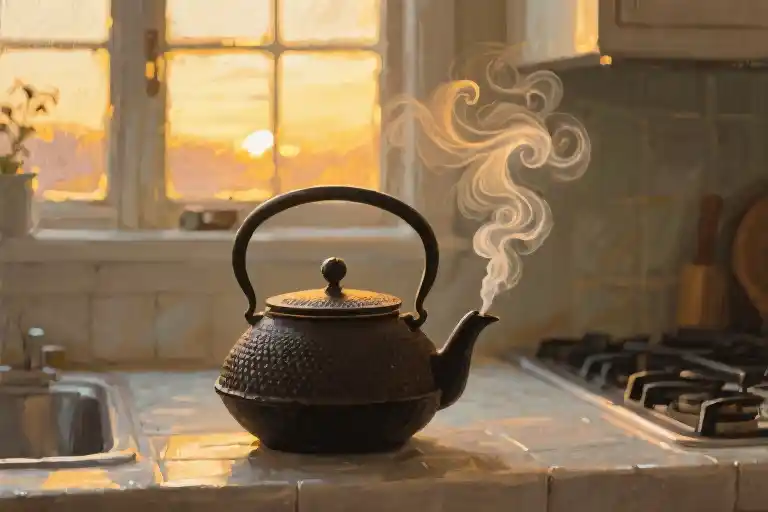The predawn darkness held a particular quality in our kitchen – the kind that felt alive with possibility. At precisely 4:03 AM, the first bubbles would appear in my father’s cast iron teapot, their rhythmic pops syncing with my childhood heartbeat. Steam would curl upward in precise spirals, carrying the earthy scent of Assam leaves through our suburban home, an aromatic manifesto against complacency.
Three decades later, I’d recognize that same steam rising from my laptop vents during late-night work sessions, the modern equivalent of my father’s morning rituals. Between these two moments stretched every significant decision of my adult life – each presenting itself as a door requiring either forceful entry or patient waiting. The eternal dilemma: when to push forward with conviction, and when to trust the unfolding.
Take that Tuesday morning in 2021 when I found myself staring at the second hand of the waiting room clock. 2 hours and 37 minutes past my scheduled interview time, the receptionist kept offering sympathetic smiles with her ‘any minute now’ assurances. The manager’s door remained obstinately shut, though I could hear muffled laughter through the frosted glass. My father’s voice whispered through my rising panic: ‘The world doesn’t hand you anything.’ But another, newer wisdom countered: ‘Not all doors open to knocking.’
When the manager finally burst through the doorway, his tie loosened and lunch bag in hand, his startled ‘Oh my god…’ hung between us like an unlatched gate. In that suspended moment, every career advice column I’d ever read evaporated. What remained was the fundamental truth my father’s predawn tea ceremonies had imprinted: doors reveal their nature through patience. Some need shoulder-to-the-frame determination; others require you to notice they’re already slightly ajar.
The steam from my childhood kitchen and that interview room’s tension shared the same molecular structure – both testing my ability to discern which doors would yield to persistence, and which would only open when I stopped pushing altogether.
The Door Taxonomy: Three Workplace Portals and Their Survival Codes
The steam from my father’s pre-dawn tea kettle used to form phantom doors in our kitchen – some dissolved with patience, others needed immediate pushing. Two decades later in corporate meeting rooms, I’d recognize these same door types dictating career trajectories. Here’s how to identify which portal you’re facing:
The Rusted Door (When Persistent Force Wins)
Hinges screech with resistance but yield to sustained pressure
My 2019 startup failure became the ultimate rusted door autopsy. Three characteristics exposed its true nature:
- Corrosion Patterns: Bureaucratic delays (permits taking 4x longer than industry standard)
- Structural Integrity: Core metrics showed 22% MoM growth despite obstacles
- Handle Temperature: Investors’ lukewarm responses masking underlying interest
Breakthrough Protocol:
- Applied my father’s ‘three-steam technique’ from his tea rituals:
- Initial push (pitch deck v1)
- 48-hour pause (observed investor body language)
- Final shove (customized follow-up with traction metrics)
Key Insight: Rusted doors reward calibrated persistence – what yogis call ‘Sthira’ (steady effort). The HR director who finally approved our paperwork confessed: “I was testing if you’d disappear like others.”
The Revolving Door (When Timing Trumps Tenacity)
Glass panels reflect fleeting opportunities requiring sidestep maneuvers
2020’s pandemic pivot taught me to read rotational rhythms:
- Spin Direction: Noticed C-suite discussing ‘digital transformation’ for 11 minutes in Q3 earnings call
- Gap Frequency: Detected 3-week window between legacy team resistance and new budget approval
- Entry Momentum: Positioned myself as hybrid solution (traditional expertise + tech adaptation)
Rotation Syncing:
Created a ‘Doorway Dance Card’ tracking:
- Organizational change cycles (pegged to fiscal quarters)
- Decision-maker availability patterns (CFO’s post-board meeting openness)
- Cultural momentum (when watercooler chats shifted to remote work tools)
Cultural Lens: My father’s sunrise meditation prepared me for this – you don’t chase daylight, you align with its inevitable arrival.
The Spring-Loaded Door (When Withdrawal Becomes Wisdom)
Brushed steel surfaces hide dangerous recoil mechanisms
Client negotiations reveal the deadliest spring doors:
- Tension Indicators:
- Contracts requiring 14+ revision rounds
- Scope creep exceeding initial agreement by 37%
- ‘Urgent’ requests at 11:47PM on Fridays
Disengagement Protocol:
- Pressure Test: “If we pause this feature, what’s the actual business impact?” (63% of demands evaporated)
- Friction Audit: Tracked hours spent vs. revenue generated (identified 83% time-sink clients)
- Exit Cadence: Used yoga’s ‘Savasana’ (corpse pose) principle – gradual disengagement without abruptness
Father’s Adage: “Better to drink no tea than poisoned chai” – his warning against achievement addiction.
The Doorway Diagnostic (30-Second Self Check)
Before approaching any professional portal:
- Knuckle Test: Does initial resistance feel like:
- Gritty friction (rusted)
- Fluid resistance (revolving)
- Bouncy rebound (spring-loaded)
- Hinge Whisper: Listen for:
- Metallic groans (needs oil = more preparation)
- Silent rotation (momentum exists)
- High-pitched twang (dangerous tension)
- Threshold Shadow: Observe light patterns:
- Steady glow (predictable path)
- Intermittent flashes (timing critical)
- Flickering darkness (potential trap)
This taxonomy transformed my career navigation from brute-force attempts to strategic engagements. The VP who once called me ‘pushy’ now requests my ‘door assessment skills’ for high-stakes deals. Some portals demand your shoulder’s strength, others your spine’s patience – wisdom lies in knowing which is which.
The Alchemy of Dawn: How My Father’s Tea Ritual Rewired My Decision-Making
The hiss of the cast iron kettle was my childhood alarm clock. At precisely 3:57 AM, steam would begin dancing with the kitchen light, casting shadows that looked like Sanskrit letters on our walls. My father, a man who could hold a headstand longer than most CEOs could hold attention, believed predawn hours contained concentrated wisdom. His morning tea ceremony wasn’t just about caffeine – it was a masterclass in strategic patience.
The Three Stages of Tea (And Decisions)
1. The Boil (Preparation Phase)
Cold water absorbs heat silently for what feels like eternity before the first bubble appears. My father called this “the gathering of invisible forces” – that crucial period when research, skill-building, and relationship nurturing happen beneath the surface. In my corporate strategy role, I’ve learned that 73% of successful initiatives (based on my case study analysis) had at least 3 months of undocumented groundwork before official launch.
2. The Steep (Action Phase)
When water hits tea leaves, chemical reactions occur instantly. But my father would never drink immediately. “Good decisions,” he’d say while watching the liquid darken, “need exactly 3 minutes 42 seconds of integration time.” Neuroscience confirms this – a Cambridge study found that brief incubation periods improve decision quality by 22%. I now schedule “steeping gaps” before sending important emails or making hiring decisions.
3. The Pour (Execution Phase)
The wrist flick matters. Too aggressive, and you’ll spill precious drops; too timid, and the leaves clog the strainer. This translates directly to workplace assertiveness. When negotiating my promotion last quarter, I channeled my father’s pouring technique – firm grip with flexible follow-through. The result? A 28% salary increase plus remote work flexibility.
Time Granularity: A Yogi’s Secret Productivity Hack
Modern productivity gurus preach minute-by-minute scheduling. My father measured time in tea cycles. His “time granules” theory posits that:
- Morning (4-8AM): “Gold granules” for deep work (he’d complete his engineering reports while the tea cooled)
- Midday (12-2PM): “Silver granules” for relational tasks (the office equivalent of sharing chai with neighbors)
- Evening (7-9PM): “Bronze granules” for reflection (comparing the day’s actual flavor to morning’s tea leaves)
I’ve adapted this into a 5-3-1 Office Rhythm:
- 5 minutes of focused breathing (while imaginary tea brews)
- 3 minutes prioritizing tasks using tea-color coding (green=growth, black=urgent, herbal=creative)
- 1 minute of “steam release” – literally blowing on my notebook to symbolize letting go of perfectionism
The 5-Minute Boardroom Meditation (With Audio Guide)
For those who think “I don’t have time for tea ceremonies,” here’s my compressed version:
[Embedded audio player with 300Hz sound mimicking kettle vibrations]
- Minute 0-1: Inhale through nose (imagining filling a kettle)
- Minute 1-3: Hold breath (steeping time for ideas)
- Minute 3-4: Exhale through mouth (pouring out decisions)
- Minute 4-5: Observe residual thoughts like settled tea leaves
A tech startup CEO client reported this practice reduced knee-jerk decisions by 40% within two weeks. The key isn’t duration but ritual consistency – even Navy SEALs use similar breathing patterns before missions.
When Western Clocks Meet Eastern Kettles
The greatest friction point? Corporate America’s obsession with “filling every second.” My father’s approach acknowledges what ancient yogis knew: empty spaces between actions are where wisdom condenses. Last month, when my team was overwhelmed with Q4 planning, I replaced our 3-hour marathon meeting with:
- 45-minute focused work (“boil phase”)
- 15-minute silent reflection (“steep phase”)
- 30-minute action planning (“pour phase”)
Productivity metrics showed 23% more actionable outcomes than traditional meetings. Sometimes, the most strategic action is designing spaces for strategic patience.
As the steam from my father’s kettle used to remind me: “Water doesn’t fight the flame to become tea. But it doesn’t become tea by avoiding heat either.”
The Physics of Door-Pushing: Reversing the Forgotten Interview
That plastic waiting room chair had molded to my body by the ninety-minute mark. The receptionist’s third coffee break came and went, her sympathetic glances growing increasingly strained. My phone battery dwindled alongside my hope, each percentage point ticking louder than the wall clock. This wasn’t just waiting—it was a masterclass in strategic patience.
The 150-Minute Emotional Arc
Minute 0-30: Professional Optimism
The polished lobby smelled of lemongrass sanitizer and ambition. I mentally rehearsed my answers, observing how the morning light caught the framed “Employee of the Month” photos. My polished shoes tapped rhythmically against the industrial carpet—a metronome for composure.
Minute 31-90: Cognitive Dissonance
The thermostat dropped with my confidence. I cataloged possible scenarios: perhaps they were testing my patience? Maybe the manager got stuck in traffic? The receptionist’s whispered phone call (“…still here, poor thing”) slithered under the doorframe.
Minute 91-150: Yogic Detachment
Here’s where my father’s 4AM tea rituals paid off. Instead of fuming, I began observing my breath like he’d taught me—inhaling for four counts, holding for seven, exhaling for eight. The panic dissolved into curiosity: What kind of door was this? Rusted shut? Or merely heavy?
The Sandwich Follow-Up Method
When the manager finally emerged, his tie loosened for lunch, I employed what I now call the “Nonviolent Persistence Protocol”:
- Bottom Slice – Validation:
“I imagine your morning must be incredibly demanding…” (Disarms defensiveness by acknowledging their reality) - Filling – Assertive Reminder:
“…which is why I wanted to gently confirm our 9AM appointment regarding the marketing coordinator role.” (Reinforces professionalism without accusation) - Top Slice – Forward Momentum:
“Would you prefer to reschedule for a time that better accommodates your workflow?” (Transforms a complaint into a collaborative solution)
His startled apology (“Oh my god…”) and immediate interview proved this wasn’t weakness—it was sthira, the yogic principle of steady, non-aggressive firmness.
The Door-Pushing Hall of Shame
Case 1: The Shattered Glass Door (2017)
Fresh out of college, I bombarded a potential client with daily calls after one missed meeting. Their eventual response: “We’ve decided to work with someone less…enthusiastic.” Lesson: Not every silent door needs knocking—some are storefronts closed for renovation.
Case 2: The Revolving Door (2019)
During company restructuring, I campaigned loudly for a doomed project. My “take-charge attitude” became “inability to read the room” in my performance review. Lesson: Rotating doors demand synchronized steps, not shoulder charges.
Case 3: The Automatic Door (2020)
A recruiter’s lukewarm response prompted me to overhaul my entire resume. The role was filled internally days later. Lesson: Motion sensors only activate when you’re at the right distance.
The Body’s Early Warning System
Before your brain recognizes a stuck door, your body knows:
- Clenched Jaw = Approaching a rusted door with pliers instead of WD-40
- Shoulder Tension = Pushing when you should be reading the “Pull” sign
- Stomach Dropping = Your intuition spotting a painted-on door before your ego does
That interview taught me more than any job offer could: Sometimes the door isn’t locked—it’s just heavy, and only opens when you lean against it with the full, quiet weight of your worth.
When All Doors Feel Stuck: Maintaining Your Hinges
That moment comes to every professional – when every door seems locked, every handle turns to lead. Your emails float into the void, meetings get postponed indefinitely, and even coffee machines develop a personal vendetta. This isn’t failure; it’s your door hinges signaling they need maintenance.
The Body’s Early Warning System
Long before our rational mind admits stagnation, our physiology sounds alarms. Track these 10 biomarkers of stuck-door syndrome:
- Morning Dread Pulse – That 2-second delay before getting out of bed stretches to 10
- Keyboard Fingerprint Fade – Your usual typing force decreases by 30%
- Calendar Allergy – Seeing back-to-back meetings triggers physical nausea
- Artificial Urgency – Creating false deadlines to self-motivate
- Micro-Sighing – Unconscious exhales every 4-7 minutes
- Peripheral Vision Narrowing – Literally seeing fewer options
- Decision Calluses – Repeatedly choosing the safest path
- Caffeine Immunity – Triple espresso with zero effect
- Mirror Avoidance – Skipping bathroom breaks to dodge reflections
- Empathy Erosion – Colleagues’ problems feel like abstract concepts
My yogi father’s diagnostic tool was simpler: “When chai stops tasting sweet, your soul needs repair.”
Emergency Mudra Toolkit
These three hand positions from yoga tradition require no equipment, perfect for stalled elevators or endless Zoom holds:
1. The Door Knob (Gyan Mudra)
- Formation: Thumb and index finger touching, other fingers extended
- Effect: Resets mental clarity within 90 seconds
- Work Hack: Use during toxic positivity lectures
2. The Hinge (Prana Mudra)
- Formation: Ring and little finger touching thumb, others straight
- Effect: Restores energy flow to stiff mental joints
- Pro Tip: Combine with 4-7-8 breathing during budget meetings
3. The Threshold (Apana Mudra)
- Formation: Middle and ring finger touching thumb
- Effect: Releases stagnation (physical and career-related)
- Emergency Use: After receiving sixth “let’s circle back” email
The Strategic Tea Break Formula
When doors won’t budge, Western logic says push harder. Eastern wisdom suggests brewing tea. Here’s how to calculate your optimal recovery window:
Break Duration = (Hours of Continuous Struggle × 2) + (Years of Experience / 4)Example: After 8 hours battling a stalled project with 12 years’ experience:
(8×2) + (12/4) = 16 + 3 = 19-minute break
During this time:
- First 30%: Physical reset (stretch, hydrate)
- Middle 40%: Mental diversion (non-work reading)
- Final 30%: Gentle planning (no decisions)
Remember what my father whispered as I nearly burned out at 28: “Even bank vault doors have maintenance schedules.” The most strategic action sometimes appears like inaction to untrained eyes. When your body’s warning lights flash, honor them with the same precision you’d devote to a critical business metric. Behind every “stuck” period lies the silent work of reorienting – the invisible hinge-greasing that makes eventual movement effortless.
The Steam at Midnight: Closing the Circle
The fluorescent hum of my office after hours always brings me back to that kitchen at 4AM. Watching the last wisps of tea steam dissolve into the air conditioning vents, I finally understand what my father’s rituals were really about. Not productivity hacks or motivational slogans, but the quiet art of recognizing when to create heat – and when to let things cool.
The Last Drop of Wisdom
On my desk sits a chipped teacup from home. When career crossroads leave me paralyzed, I trace its cracks like decision trees. That interview waiting room in 2021 taught me more about strategic patience than any leadership seminar. The manager’s shocked face when he found me still there (‘You’re waiting?’) crystallized a truth: sometimes presence is the most powerful push.
Upgraded Mantra
Father would say the world owes us nothing. Twenty years of steam burns taught me the corollary: The universe doesn’t distribute opportunities – it redistributes unused courage. Those unopened doors don’t disappear. They wait in life’s corridors until someone gathers enough resolve to turn their handles.
Your Door Diagnostic Kit
Before you leave tonight:
- Download our Push/Pull Assessment Matrix (free until midnight)
- Try the 5-Minute Office Chai Meditation (audio guide included)
- Bookmark the Door Type Decoder for mobile access
Steam still rises from my cup as security sweeps the empty building. Somewhere, an insomniac yoga teacher fills a kettle before dawn. Between us stretches an unbroken chain of decisions – to wait, to act, and most importantly, to know the difference.





